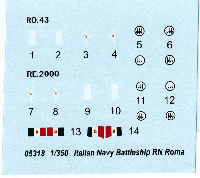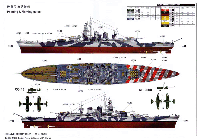| HISTORY |
|
|
The Vittorio Veneto class was the last class of battleships to be built by the Italian Navy- the Regia Marina. This class of battleships were designed to maximize the standards under the Washington Treaty, while meeting the operational requirements of the Italian Navy and the logistical limitations of Italian manufacturing. This led to a class of ships said to be some of the most aesthetically pleasing capitol ships ever built. Armed with nine 381mm (15") guns in three triple turrets as the main battery, twelve 152mm (6") guns in four triple turrets as a single purpose secondary battery, and 12 90mm AA guns in stabilized mounts, six to each side amidships, these ships were also mostly well protected for their weight. One of the limitations accepted to keep the total tonnage down for the class was a limitation in range, since these ships were never intended to operate outside the Mediterranean Basin.
Of the four ships in the class built, Roma was the third; the first ship in the second group of two. After Littorio and Vittorio Veneto were found to be very wet at speed, Roma and Impero were designed with a raised bow. Roma also differed by having one anchor each to port and starboard; the other ships had one port and two to starboard.
Roma was launched on the 9 of June, 1940; one day before Italy entered the war. Roma was lost 9 September 1943, after being hit by two Fritz X German guided glide bombs; she quickly broke in two and sank, taking most of her crew with her.
Trumpeter's long and anxiously awaited 1/350 Roma has been released. This kit's packaging and layout of assembly are standard Trumpeter fare. This review sample appears to be from early in the production run, as it has some spots stained with grease from the molds. While always a good idea to wash your kits, be sure to inspect your Roma before assembly; wash with warm water and dish detergent, and allow to air dry before assembly.
|
| HULL AND DECK |
|
|
Molded in Trumpeter's standard grey upper and red lower hull, this kit also has a red waterline plate which fits snugly into the upper hull. The waterline plate and lower hull both mate snugly with the upper hull section; the fit of the two hull halves is one of the best Trumpeter has achieved.
The upper hull has a large central deck molded in place, leaving the forecastle and quarterdecks as separate parts. It is unknown if the loose forecastle part is due to mold constraints or if Trumpeter intends to release some of Roma's sister ships with the earlier, lower bow and doubled anchors on the starboard side. This part has some great detail, including some plating details, along with portholes and other hull openings. The armor belt is well represented, one of the unique elements of these elegant battleships. The emblem on the bow of Roma is missing; as launched, there was a star present, which was later replaced with the coat of arms of the city of Rome- Trumpeter has left the bow smooth.
The forecastle part is covered in details, with some great detail to the various fittings present. The surface detail pattern looks good- but should be a raised pattern, not recessed into the deck. There are no molded on anchor chains; Trumpeter has provided a real metal linked chain to add for this purpose. Also, many of the fittings are molded with a "cross" detail on the top; these details, while correct, are overscale. There are detailed locations for the foredeck mounted Breda 37/54 AA guns, but no apparent provision to model these guns retracted into their watertight hatches.
The lower hull has no plating detail, but the Pugliese underwater protection systems bulges are clearly present. Due to the complexity of these shapes, the bilge keels have been molded separately from the hull- a change from normal Trumpeter practice, but one that serves in good stead; molded on bilge keels tend to be overscale. The 1/350 lower hull has some similar problems as the 1/700 kit; the auxiliary rudder areas are not flared into the hull, and the paravanes streaming plate on the extreme bow is very thick. The outer shafts are too far inboard, and the auxiliary rudders are angled inboard as well (they should be perpendicular).
While the hull parts fit well together, dimensionally they are off; a waterline length of 232.4m should work out to 26.14"; the kit measures to 26.5, or almost 1/2" to long. The waterline beam of 32.4m equates to 3.64", while the kit measures 3.56"; a difference of .08"
|
|
 |
|
|
| SPRUE A |
|
This first sprue of Roma has some basic parts, with most of the lower hull propulsion parts. The skegs and shafts for the 4 propellers, along with the shaft supports and main rudder are present. The parts to make the searchlight tower, along with the tubs for the Breda AA guns which fit atop the No. 2 and No. 3 turrets are also here.
The aircraft catapult sides have some good detail, showing both rivets and girder shapes. The rail, which mounts on the quarterdeck and supports the end of the catapult is also on this sprue.
The main rudder is poorly shaped, and will require extensive sanding to correct.
The skeg to shaft transition is too abrupt, and should "step" down to the shaft.
|
 |
|
|
| SPRUE B |
|
B has the bilge keels, the foredeck breakwater and various details around the ship. One of the interesting pieces is the 12.25m diesel launch, a boat that was designed and built special for the Littorio class of battleships. The lower "tactical" rangefinder parts are on this sprue as well.
|
 |
|
|
| SPRUE C |
|
Sprue C has the primary 01 level deck, and various bulkheads which comprise the superstructure. These bulkheads have good detail, and have the appropriate hatches, covers and portholes specific to Italian vessels of this time. The 01 level has the 4 "San Giorgio" electric winches for hoisting the ships boats molded in place.
The model's nameplate is also on this sprue, as are both the bridge and admiral's bridge armored windows.
|
 |
|
|
| SPRUE D |
|
D has the ship's funnels and funnel caps, the armored conning tower, and the lookout deck. The raised amidships (central) anti-aircraft platforms which mount behind the primary 90mm AA guns are also here. This platform has some textured deck details, and the ready service ammo lockers are molded on with the shields.
There are additional levels to the conning tower superstructure here as well, along with the starfish for the foremast.
|
 |
|
|
| SPRUE E |
|
Sprue E has the quarterdeck piece, and more bulkheads for the superstructure and conning tower assemblies. The quarterdeck is the only planked deck on Roma, and is planked with the staggered pattern, repeating every 5 planks. Like the forecastle, the quarterdeck has various fittings and hatches molded on.
|
 |
|
|
| SPRUE F X2 |
|
This sprue has some more flat bulkheads, hose reels and the 3m AA rangefinders for the spotting deck.
|
 |
|
|
| SPRUE G1 X4 |
|
The instructions show sprue "G" has a single sprue, but this sprue has been packaged separately as "G1" and "G2" in the kit.
Sprue G1 has the hull halves for the diesel cutters, some parts to the raised bases for the 90mm guns, the Breda 37/54 stabilized twin AA guns, and the barrels for the 381mm main guns. These barrels have open muzzles, and come with two options: with or without blast bags. Neither the barrel not the sleeve appear to have the correct taper; the sleeve should taper smoothly to the barrel, and the muzzle ring is overscale. Additionally, the blast bag/bloomers leave a bit to be desired.
This half sprue also includes the anchor flukes, some reels, and some stabilized spotting binoculars.
|
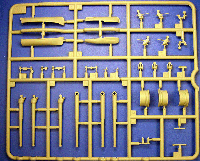 |
|
|
| SPRUE G2 X4 |
|
G2, the other half of the "G" sprue, has the remaining half of the 90mm bases, along with the 90mm turrets and barrels. The 120/40 guns with shield, used for firing illuminating rounds, are also present with the searchlights and the rest of the cutters.
The shape of the 90mm turret is well represented, with raised rivet detail accentuating the whole. The base for these guns is missing the rubberized skirt that was added as an attempt to reduce water damage to the interiors of this stabilized mount. The 90mm barrels are very simplified, and are missing any provision for blast bag/bloomers.
The 120 armstrongs are nicely detailed, as befitting the open shield mounts, and should look good when mounted to the decks.
Completing the armaments on G2 are the Breda twin 20/65 mounts, which were also stabilized.
|
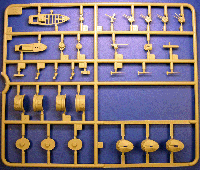 |
|
|
| SPRUE H X4 |
|
Sprue H has the main and secondary turrets, along with the base of each 90mm turret and the Carley floats found on the Roma. The floats have been somewhat simplified for molding purposes.
The main 381mm turrets have the rangefinder hood (called "ears" by some) molded separately. The bolt detail for these armored hoods is molded on to the turret. The general shape of the turret is sound, but there is a raised lip to the roof of the turret that should not be present. Each of the main turrets on Roma was unique in appearance, and will require modification from these identical turrets provided by Trumpeter.
The 152mm single-purpose secondary guns, referred to as the anti-torpedo boat armament, are mounted in triple turrets. Both the barrels and these turrets are found on sprue H. The barrels are not done very well. While the taper appears correct, there is a large ring attached to the end of the barrel, which does not have an open muzzle. These barrels fit into the turret only one way, with a pre-molded bag attached to the base. The base of these barrels should have a ejection port for propellant cartridges. The turret openings for the barrels also do not appear to extend far enough into the top of the turret.
Both the main and secondary turrets will require holes to be drilled from the inside before assembly. There will be two patterns of holes for the secondary turrets, and each of the mains is unique in its pattern, so exercise caution during assembly.
|
 |
|
|
| SPRUE J X2 |
|
The final sprue for Roma is a catch-all of assorted parts. This includes another 13m diesel cutter, various other ship's boats, the triple-bladed screws, and the auxiliary rudders. The aux rudders are as poorly shaped as the main one, and will need some sanding and scribing work to correct.
|
 |
|
|
| RO.43 |
|
This kit of Roma carries parts for two different types of aircraft, the IMAM Ro.43 and the Reggiane Re.2000- one of each type. The Ro.43 floatplane was a moribund reconnaissance biplane, ill-suited for most uses required of them, but they continued in service well into the war.
|
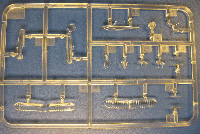 |
|
|
| RE-2000 |
|
This second of the two aircraft types included, the Reggiane Re.2000 was designed as an interceptor. Interestingly, the Re.2000 was not a floatplane, but rather this
aircraft was a carrier version of a land-based fighter. As Italy did not have an aircraft carrier, the Regia Marina experimented with launching them from cruisers and battleships. As the RM would rarely operate far from land, these aircraft could be catapult launched from sea on a one-way trip; perform their mission, and return to an airfield ashore.
|
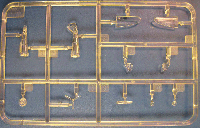 |
|
|
| PHOTOETCH |
|
A small photoetch fret is included. This fret has parts for the aircraft handling crane, paravane cranes, the catapult launching cradle, deck cradles for the aircraft,
and interior baffles and screens for the exhaust stacks. There are also parts to make the Gufo radar horns. One slight departure from other Trumpeter kits, some these photoetch parts are not optional; there are no plastic equivalents included. The cranes and depth charge racks are optional parts.
There is also a small length of metal chain included for the anchors.
|
 |
|
|



